Short Quick Answer
Apply "stereotypes" and "notes" to extend U.M.L. Diagrams
Long Boring Extended Answer
You question is a valid one.
There is not a general standard for this at the "Sequence Diagram (s)", directly.
Indirectly, I have seen many "Sequence Diagram (s)", like this case, split this into 2 or more diagrams, where there is a diagram for the "Visitor registers into Website", and another diagram, "Visitor becomes User, by loggin into Website", that extends the first diagram.
Remember, that many "Sequence Diagram (s)" are represented by a small "Use Case Diagram", with "Actor (s)", and both "Actor (s)" and "Use Case Diagram (s)" can use the <<extend>> stereotype.
An example of an "User" Actor being extended by another Actor, [without Use Case (s) ], could be something like this:
..................................
....(o)...................(o).....
.....|.....................|......
..---+---...............---+---...
.....|......<<extend>>.....|......
.....|<--------------------|......
.....^.....................^......
..../.\.................../.\.....
.../...\................./...\....
..................................
..Visitor.................User....
..................................
An example of a Use Case being extended by another Use Case, [without Actor (s) ], could be something like this:
....................................................................
......------------------.....................------------------.....
..../...................\................../...................\....
.../.....................\................/.....................\...
..|......Visitor..........|..<<extend>>..|......Visitor..........|..
..|......Arrives To.......|<-------------|......Registers........|..
..|......Website..........|..............|......Into Website.....|..
...\...................../................\...................../...
....\.................../..................\.................../....
.....-------------------....................-------------------.....
....................................................................
And, this situation is very common, and, frequent, to be consider a "defacto", standard.
Is not bad, and is not an error, that you jump straight ahead to the "Sequence Diagram (s)".
Yet, maybe you should:
[1] Add a "Visitor arrives to Website" Use Case diagram, with an actor called "Visitor"
..............................................
....................-------------------.......
.................../....................\.....
....(o).........../......................\....
.....|.........../........................\...
..---+---.......|........Visitor...........|..
.....|..........|........Arrives To........|..
.....|.=========|........Website...........|..
.....^..........|..........................|..
..../.\.........|..........................|..
.../...\.........\......................../...
..................\....................../....
..Visitor..........\..................../.....
....................--------------------......
..............................................
[2] Add the related "Visitor becomes User, by registering into Website" Use Case diagram, with an actor called "Visitor"
.........................................................
....................-------------------..................
.................../....................\................
....(o).........../......................\...............
.....|.........../........................\..............
..---+---.......|......Visitor.............|.............
.....|..........|......becomes.User........|.............
.....|.=========|......by.registering......|.............
.....^..........|......Into.Website........|.............
..../.\.........|..........................|.............
.../...\.........\......................../..............
..................\....................../...............
...Visitor.........\..................../................
....................--------------------.................
.........................................................
[3] Add the related "User logs into Website" Use Case diagram, with an actor called "User"
.........................................................
....................-------------------..................
.................../....................\................
....(o).........../......................\...............
.....|.........../........................\..............
..---+---.......|.......User Logs..........|.............
.....|..........|........Into.Website......|.............
.....|.=========|..........................|.............
.....^..........|..........................|.............
..../.\.........|..........................|.............
.../...\.........\......................../..............
..................\....................../...............
....User...........\..................../................
....................-------------------..................
.........................................................
[4] Merge the previous diagrams, into a single one, with the <<extends>> stereotype
.....................................................................................
....................-------------------..............................................
.................../....................\............................................
....(o).........../......................\...........................................
.....|.........../........................\..........................................
..---+---.......|........Visitor...........|.........................................
.....|..........|........Arrives To........|.........................................
.....|.=========|........Website...........|.........................................
.....^..........|..........................|.........................................
..../.\.........|..........................|.........................................
.../...\.........\......................../..........................................
..................\....................../...........................................
..Visitor..........\..................../............................................
....................--------------------.............................................
.............................^.......................................................
.............................|.......................................................
.............................|..<<extends>>..........................................
.............................|.......................................................
....................-------------------..............................................
.................../....................\............................................
....(o).........../......................\...........................................
.....|.........../........................\..........................................
..---+---.......|......Visitor.............|.........................................
.....|..........|......becomes.User........|.........................................
.....|.=========|......by.registering......|.........................................
.....^..........|......Into.Website........|.........................................
..../.\.........|..........................|.........................................
.../...\.........\......................../..........................................
..................\......................O...........................................
...Visitor.........\..................../.\..........................................
.....^..............--------------------...\....+------------------------------+--+..
.....|...................^..................\...| "Visitor" becomes "User", \ |..
.....|...................|...................\..| by registering, \|..
.....|..<<extends>>......|..<<extends>>......+--O into website +..
.....|...................|................../...| |..
.....|..............-------------------..../....+---------------------------------+..
.....|............./....................\./..........................................
....(o).........../......................O...........................................
.....|.........../........................\..........................................
..---+---.......|.....User Logs............|.........................................
.....|..........|......Into.Website........|.........................................
.....|.=========|..........................|.........................................
.....^..........|..........................|.........................................
..../.\.........|..........................|.........................................
.../...\.........\......................../..........................................
..................\....................../...........................................
....User...........\..................../............................................
....................-------------------..............................................
.....................................................................................
[5] Describe each nested Use Case diagrams with its corresponding Sequence diagram (s)
[6] Add notes to each nested Use Case diagrams, indicating there is a Sequence diagram
...................................................................
..................+------------------------------+--+..............
..Visitor.........| "Visitor" arrives \ |..............
..................| to website \|..............
....(o)..O--------O +..............
..---+---.........| |..............
.....|............+---------------------------------+..............
.....|.............................................................
.....^..............+---------+..........+-----------+.............
..../.\.............| Website |..........| Database |.............
.../...\............+----+----+..........+-----+-----+.............
.....|...................|.....................|...................
....+-+-+..............+-+-+.................+-+-+.................
....| |..Arrives.....| |..DoSomething()..| |..DoSomething()..
....| +=============>+ +---------------->+ +---+.............
....| |..............| |.................| |...|.............
....| +<-------------+ +<----------------+ +<--+.............
....| |..............| |.................| |.................
....+-+-+..............+-+-+.................+-+-+.................
...................................................................
[7] Add notes to each Sequence diagram, indicating, it describes a Use Case diagram
.....................................................................................
....................-------------------..............................................
.................../....................\............................................
....(o).........../......................\...........................................
.....|.........../........................\..........................................
..---+---.......|........Visitor...........|....+------------------------------+--+..
.....|..........|........Arrives To........|....| \ |..
.....|.=========|........Website...........|....| Detailed by corresponding \|..
.....^..........|..........................O----O Sequence Diagram +..
..../.\.........|..........................|....| |..
.../...\.........\......................../.....+---------------------------------+..
..................\....................../...........................................
..Visitor..........\..................../............................................
....................--------------------.............................................
.............................^.......................................................
.............................|.......................................................
.............................|..<<extends>>..........................................
.............................|.......................................................
....................-------------------..............................................
.................../....................\............................................
....(o).........../......................\...........................................
.....|.........../........................\..........................................
..---+---.......|......Visitor.............|....+------------------------------+--+..
.....|..........|......becomes.User........|....| \ |..
.....|.=========|......by.registering......|....| Detailed by corresponding \|..
.....^..........|......into.Website........O----O Sequence Diagram +..
..../.\.........|..........................|....| |..
.../...\.........\......................../.....+---------------------------------+..
..................\......................O...........................................
...Visitor.........\..................../.\..........................................
.....^..............--------------------...\....+------------------------------+--+..
.....|...................^..................\...| "Visitor" becomes "User", \ |..
.....|...................|...................\..| by registering, \|..
.....|..<<extends>>......|..<<extends>>......+--O into website +..
.....|...................|................../...| |..
.....|..............-------------------..../....+---------------------------------+..
.....|............./....................\./..........................................
....(o).........../......................O...........................................
.....|.........../........................\..........................................
..---+---.......|.....User Logs............|....+------------------------------+--+..
.....|..........|......into.Website........|....| \ |..
.....|.=========|..........................|....| Detailed by corresponding \|..
.....^..........|..........................O----O Sequence Diagram +..
..../.\.........|..........................|....| |..
.../...\.........\......................../.....+---------------------------------+..
..................\....................../...........................................
....User...........\..................../............................................
....................-------------------..............................................
.....................................................................................
[EDIT: Added several ASCII U.M.L. Diagrams]
Done.

